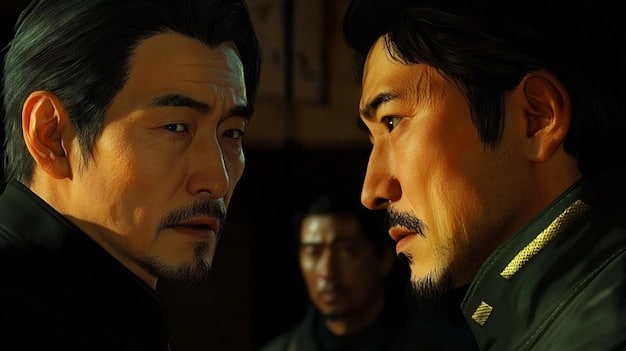Decoding Japanese Drama Endings: Ambiguity & Controversial Finales Explained

Advertisements
Japanese drama endings often leave viewers pondering due to their ambiguous or controversial nature, sparking discussions and varied interpretations regarding the characters’ fates and the overall message of the story.
Japanese dramas, or J-dramas, have captured the hearts of viewers worldwide with their compelling storylines, relatable characters, and unique cultural perspectives. However, one aspect that often leaves audiences both intrigued and perplexed is the endings. Decoding Japanese drama endings can be a tricky endeavor, as they frequently deviate from the neatly wrapped-up conclusions typical of Western television.
Anúncios
Understanding Ambiguous Endings in Japanese Dramas
Ambiguous endings in Japanese dramas are not necessarily a sign of poor writing or a lack of resolution. Instead, they often serve a specific purpose, inviting viewers to actively engage with the story and interpret the characters’ fates for themselves. This approach can lead to richer and more memorable viewing experiences, as audiences are left to ponder the themes and implications of the drama long after the credits have rolled.
Cultural Context
One key factor in understanding ambiguous endings is the cultural context of Japan. Unlike Western storytelling traditions that often prioritize closure and clear-cut resolutions, Japanese narratives often embrace a more nuanced and open-ended approach. This stems from cultural values such as harmony, indirectness, and a tolerance for uncertainty.
Anúncios
Thematic Depth
Ambiguous endings often enhance the thematic depth of a drama. By leaving certain questions unanswered, the writers encourage viewers to consider the broader implications of the story and the challenges faced by the characters. This can lead to a more profound understanding of the themes explored, such as love, loss, identity, and societal pressures.
- Leaving room for individual interpretation.
- Focusing on the journey rather than the destination.
- Encouraging reflection on the themes of the drama.
Japanese dramas frequently explore complex themes that resonate with viewers on a personal level. By avoiding easy answers and offering ambiguous endings, these dramas challenge audiences to confront uncomfortable truths and consider different perspectives on life’s challenges. They prompt viewers to think critically about the characters’ choices and the potential consequences of their actions.
Exploring Common Tropes in J-Drama Endings
While each Japanese drama is unique, there are some common tropes that often appear in their endings. Understanding these tropes can provide valuable insights into the possible meanings and interpretations of ambiguous finales.
One common trope is the “bittersweet” ending, where the characters achieve some measure of success or happiness, but not without significant sacrifice or loss. This type of ending acknowledges the complexities of life and the fact that happiness is often intertwined with sadness. It can be emotionally resonant, leaving viewers with a sense of both satisfaction and longing.

Open-Ended Romances
Love is a central theme in many Japanese dramas, and romantic relationships often play a significant role in the storyline. However, J-dramas frequently depart from the typical “happily ever after” trope commonly found in Western romances. Instead, they often present open-ended romances where the characters’ future together remains uncertain.
Unresolved Conflicts
Another common trope is the unresolved conflict, where the main characters fail to fully resolve their internal struggles or external challenges. This can be frustrating for viewers who crave closure, but it also reflects the reality that life is often messy and unpredictable. Sometimes, the most meaningful conclusions are those that remain open to interpretation.
- The “bittersweet” ending: A mix of happiness and sadness.
- Open-ended romances: Uncertain futures for couples.
- Unresolved conflicts: Characters facing lingering challenges.
Tropes like the bittersweet conclusion with elements of romance, loss, and character sacrifice, reflect the nuances of human relationships and emotional journeys, prompting viewers to empathize with the complexities of life. Japanese dramas employ these narrative tropes to create a deeper viewing experience, eliciting a plethora of discussions among fans.
Controversial Finales That Divided Audiences
Some Japanese drama endings are not just ambiguous, but downright controversial. These finales often spark heated debates among viewers, with some praising their boldness and originality, while others criticize them for being unsatisfying or illogical.
One example of a controversial ending is the “bad ending,” where the main characters fail to achieve their goals, face tragic consequences, or even die. While these endings can be emotionally devastating, they can also be incredibly powerful, forcing viewers to confront the harsh realities of life and the limitations of human agency.
The “Asspull” Ending
Another common complaint is the “asspull” ending, where the writers introduce a sudden and unexpected twist that feels unearned or inconsistent with the rest of the drama. These twists can be shocking and memorable, but they can also undermine the integrity of the story and leave viewers feeling cheated.
Downer Endings
Downer endings are some of the most controversial in Japanese dramas. These conclusions often involve significant loss, tragedy, or unfulfilled potential for the main characters. While downer endings can be emotionally powerful and thought-provoking, they often trigger strong reactions ranging from deep appreciation to intense dislike among audiences.
- The “bad ending”: When characters face failure or death.
- The “asspull” ending: Sudden, unearned twists.
- The “downer” ending: Leaving viewers with feelings of sadness or despair.
Controversial finales are an important aspect of the J-drama landscape. While these endings may not always be popular, they often spark important conversations about the nature of storytelling, the role of the audience, and the complexities of human experience, pushing artistic boundaries and prompting extensive reflection.
Analyzing the Impact of Open Endings on Viewers
Open endings in Japanese dramas provoke a variety of reactions from viewers. Unlike the neat resolutions typical of Western dramas, J-dramas often leave audiences pondering the characters’ fates and the overall meaning of the story.
Many viewers appreciate the intellectual stimulation and emotional depth that ambiguous endings provide, while others find them frustrating and unsatisfying. Ultimately, the impact of an open ending depends on the individual viewer’s expectations, preferences, and cultural background.

Encouraging Discussion
Open endings often encourage discussion and debate among viewers. With no definitive resolution provided, fans are left to speculate about the characters’ future, analyze the themes of the drama, and share their own interpretations of the story. This can create a sense of community and shared experience, as viewers come together to make sense of the ambiguous conclusion.
Lingering Impact
One of the most significant impacts of open endings is their ability to linger in the minds of viewers long after the drama has ended. Unlike neatly tied-up conclusions that are easily forgotten, ambiguous finales often spark long-term reflection and contemplation. The unanswered questions and unresolved conflicts continue to resonate with viewers, prompting them to revisit the themes and characters of the drama in their own lives.
- Stimulating intellectual engagement and emotional depth.
- Spawning discussions and debates among viewers.
- Creating lasting impressions and prompting long-term reflection.
Open endings not only challenge conventional storytelling but also create a personal and dynamic viewing experience. These endings invite viewers to become active participants in constructing the narrative’s meaning, ensuring the drama’s impact remains long after the final scene fades.
Popular Japanese Dramas Known for Their Endings
Several J-dramas have gained recognition for their distinctive endings, either through their ambiguity or controversial conclusions. These dramas have often become subjects of in-depth discussions, with fans dissecting the narrative choices in search of meaning and resolution.
These endings evoke lasting impressions, illustrating how creative storytelling can deeply resonate with audiences. These popular J-dramas serve as benchmarks in the industry, demonstrating how a compelling narrative, combined with a memorable conclusion, can achieve enduring fame and initiate countless discussions.
“1 Litre of Tears”
This drama tells the story of a young girl diagnosed with spinocerebellar degeneration. While the ending isn’t necessarily ambiguous, it is undeniably heart-wrenching and realistic, showing the progression of her disease and the impact it has on her and her family. This drama is praised for its honest portrayal of suffering and the importance of cherishing life.
“Long Vacation”
Is a classic romance known for its gentle pace and relatable characters. The final episode sees the main characters seemingly on the verge of a conventional happy ending. However, some viewers argue that the ending is more ambiguous, with questions remaining about the long-term prospects of their relationship.
- “1 Litre of Tears”: A tragic portrayal of a terminal illness.
- “Long Vacation”: A romance with a potentially ambiguous but hopeful ending.
These renowned dramas represent a spectrum of narrative approaches, highlighting how diverse endings can evoke strong emotional and intellectual responses. They validate the capacity of Japanese dramas to deeply engage audiences by leaving a lasting impression that extends far beyond the viewing experience.
Tips for Interpreting Challenging Japanese Drama Finales
Interpreting Japanese drama finales can be a rewarding experience, but it also requires a certain level of openness and willingness to embrace uncertainty. Here are some tips to help you navigate the complexities of ambiguous and controversial endings.
By considering historical context, analyzing symbolic elements, and engaging with fellow viewers, you can gain a deeper appreciation and understanding of these thought-provoking narratives. These tips aid in demystifying complex finales and cultivating a profound comprehension of the creative choices made by writers and directors.
Consider Cultural Context
As mentioned earlier, cultural context plays a significant role in shaping Japanese narratives. Take some time to research Japanese values, beliefs, and social norms to gain a better understanding of the cultural nuances that may be influencing the ending. This context can often reveal hidden meanings and provide deeper insight into the characters’ motivations and actions.
Analyze Symbolic Elements
Japanese dramas often incorporate symbolic elements, such as recurring motifs, visual metaphors, and symbolic objects. Pay attention to these elements, as they can provide clues about the underlying themes and message of the drama. Symbolic analysis can unlock layers of meaning and unveil the deeper intentions of filmmakers, enhancing a fuller appreciation.
- Research Japanese cultural values and beliefs.
- Pay attention to symbolic elements within the drama.
Successfully deciphering difficult Japanese drama finales relies on carefully merging cultural awareness, meticulous analysis, and community participation. By actively engaging with the content and exchanging ideas with other viewers, one can transform complex narratives into enriching learning experiences.
| Key Point | Brief Description |
|---|---|
| 🤔 Ambiguous Endings | Invite viewer interpretation. |
| 💔 Emotional Depth | Explore complex themes like loss and love. |
| 🗣️ Discussions | Spark heated debates among fans. |
| 💡 Tips | Consider cultural context and symbolism. |
Frequently Asked Questions
▼
Ambiguous endings encourage deeper viewer engagement by prompting personal interpretation and reflection on themes rather than providing definitive answers. This approach aligns with Japanese cultural values, which often appreciate subtlety.
▼
A prevalent trope is the “bittersweet ending,” where characters experience both success and significant loss, mirroring life’s complexities. It leaves viewers with mixed emotions, prompting deep contemplation.
▼
Controversial finales often elicit strong reactions, sparking debates and discussions about narrative choices and character fates. These endings challenge conventions, leading to diverse audience interpretations.
▼
Yes, open endings promote deeper engagement and extended reflection, staying with viewers long after the drama concludes. This prolonged contemplation ensures that themes and characters continue to influence thoughts.
▼
Consider cultural and historical contexts, analyze symbolic components, and engage with fellow viewers to thoroughly interpret Japanese drama finales. This approach increases understanding and maximizes the viewing experience.
Conclusion
In conclusion, the ambiguous and controversial endings of Japanese dramas invite viewers into a deeper realm of storytelling. By prompting personal interpretation and reflection, these finales enhance the viewing experience, causing contemplation and conversation, and leaving lasting impressions. Recognizing the cultural, symbolic, and fan-based analysis enhances the appreciation of J-drama endings.





